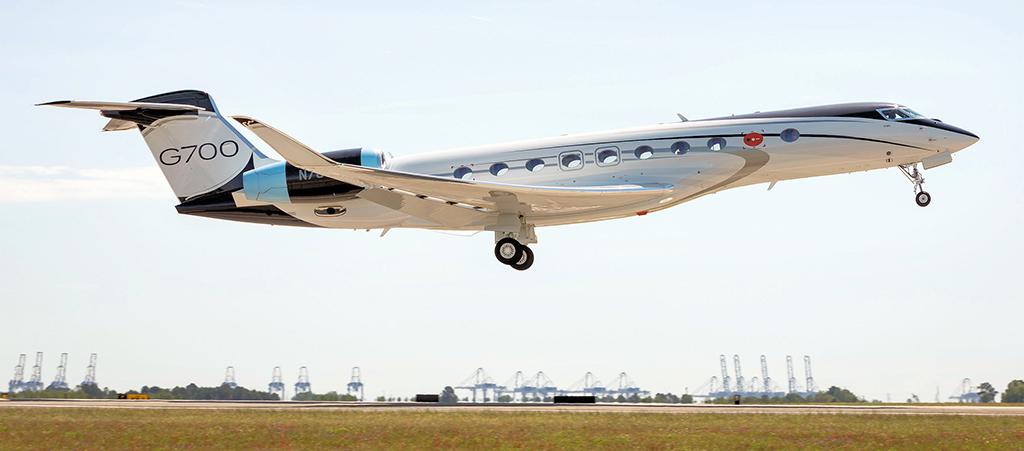
Gulfstream G700
Credit: Gulfstream
Gulftream’s innovation conveyor belt just keeps rolling along. Last Aug. 8, customers began receiving the 19-passenger, four-cabin, extra-long-range G600 less than a year after a similar debut for the slightly smaller, three-cabin (but still 19-seat) G500. Then, with scarcely a pause for breath, on Oct. 21—amid typical Las Vegas razzmatazz—NBAA convention delegates witnessed unveiling of the $75 million G700, the company’s largest, heaviest, roomiest business jet, whose twin Rolls-Royce Pearl 700 turbofans bestow 7,500-nm range. Though they brought only the mockup of the five-zone cabin to Sin City, Gulfstream proved it was not gambling on a “brochure airplane” by announcing fleet orders from Qatar Executive and Flexjet and showing video of the completed G700 prototype conducting taxiing trials at its Savannah, Georgia, headquarters. Following a maiden sortie on Feb. 14, that aircraft was joined in the air swiftly by a further pair (on March 20 and May 8). The trio already has demonstrated an altitude of 54,000 ft. and a speed of Mach 0.94 on the way to 2022 certification.
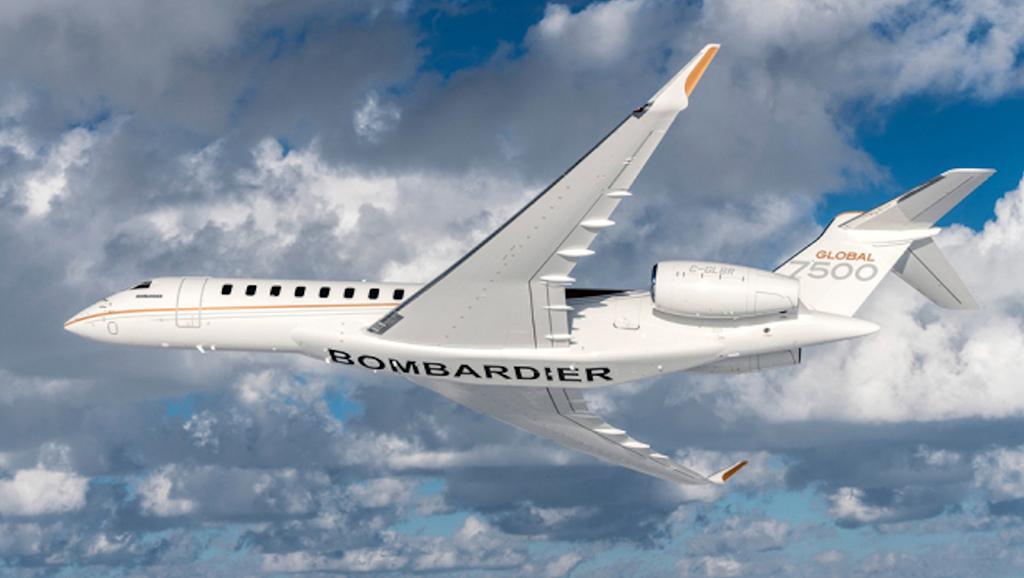
Bombardier Globals
Credit: Bombardier
It was at Geneva’s EBACE two years ago that Bombardier and Rolls-Royce astounded the business aviation world by announcing they had reinvigorated the Global 5000 and 6000 series by installing a pair of just-certified 15,125-lb.-thrust Pearl 15 turbofans to produce the 5500 and 6500. Now approved by the FAA, European Union Aviation Safety Agency and Transport Canada, the pair—of which the 5500 has the shorter fuselage, but greater (5,900-nm) range—feature redesigned cabins including the innovative, patented Nuage seat. Also newly certified, the 19-passenger Global 7500 entered service in December 2018, powered by a pair of GE Passport 20 16,500-lb.-thrust turbofans. It offers a range of 7,700 nm, but has demonstrated over 8,000 nm under favorable circumstances. Running at least three years late, the promised Global 8000 will take up to 17 passengers in its three-zone cabin, flying 7,900 nm at Mach 0.85 with a reduced complement of eight.
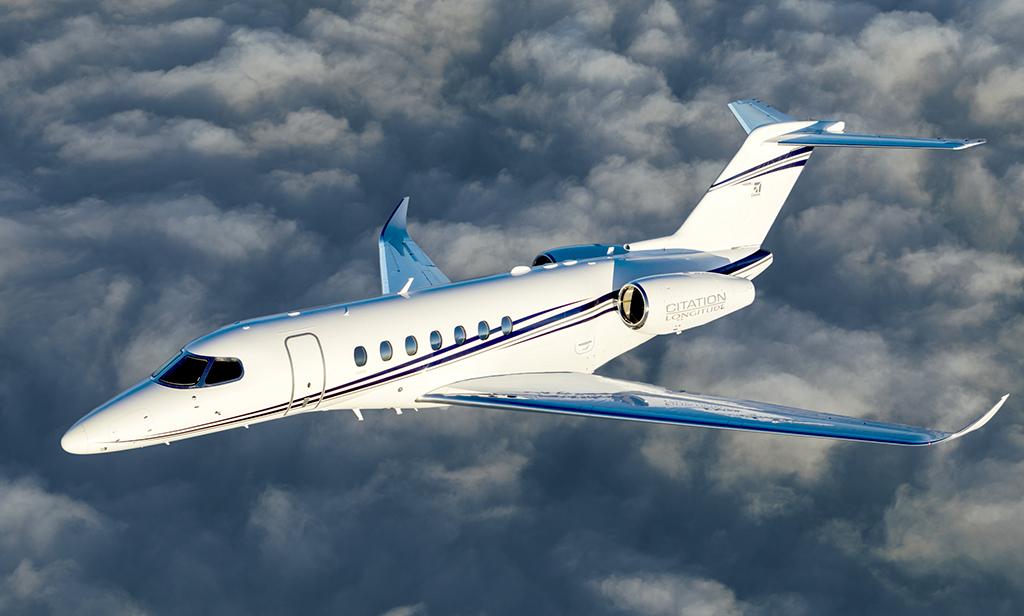
Cessna Longitude
Credit: Textron
After some inflight changes of course since conceived in 2012, the super-midsize Model 700 Longitude gained its unqualified FAA certification on Sept. 21, 2019, and began customer deliveries on Oct. 2. Major client Netjets, with an order for 150, received its first on the final day of last year—one of 13 handed over in the final three months of 2019. Seating up to 12 passengers, the $27 million Longitude features a 6-ft.-headroom, flat-floor cabin with a standard double-club configuration for maximizing legroom and is pressurized to an equivalent altitude of 5,950 ft. Appropriately named, this longest-range of the Citations will span 3,500 nm when lightly loaded with four passengers—equivalent to a 1,600-lb. full-fuel payload. Maximum cruising speed is 483 kt. Up front, the crew also benefits from the 7,665-lb.-thrust Honeywell HTF7700L turbofan engines having fully integrated autothrottles with envelope protection and Garmin G5000 avionics.
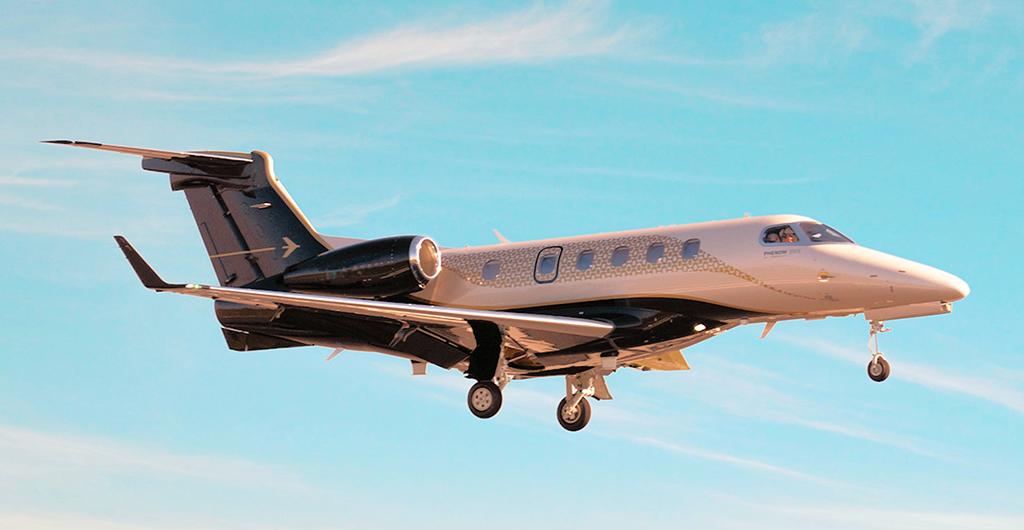
Embraer Phenom 300E Enhanced
Credit: Embraer
Embraer Executive Jets announced March 27 that the third iteration of its six-passenger, two-crew Phenom 300E light jet earned a “hat trick,” receiving type certification from three aviation authorities: the National Civil Aviation Agency of Brazil, European Union Aviation Safety Agency and FAA. The Phenom 300E Enhanced achieved certification with a 2,010-nm range, high-speed cruise of 454 kt. and a maximum payload of 2,636 lb. It also received avionics upgrades and enhancements to lower cabin noise. The Phenom 300E’s avionics upgrade includes a runway-overrun awareness and alerting system, predictive wind shear and emergency descent mode. Pilot and copilot seat-tracking has been increased to provide almost 40% more legroom. Available for delivery now, this newest version of the category-leading aircraft carries a base price of $9.65 million, but with popular options we estimate the final tally at $10.15 million. More than 500 Phenom 300s have been delivered since its entry into service in 2009.
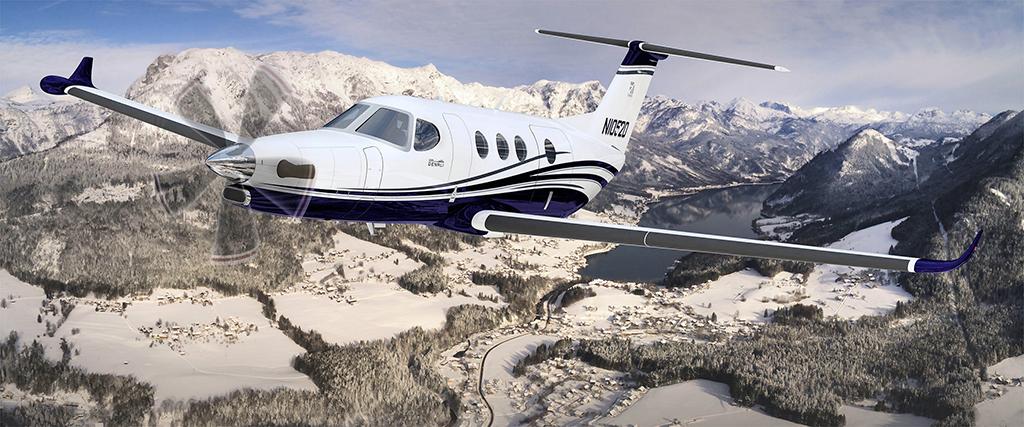
Cessna Denali
Credit: Textron
To get the much-delayed Denali into the air, Cessna needs a catalyst. Powered by the new 1,300-shp General Electric GE93 Catalyst single-power-lever turboprop, the aircraft is at least two years behind schedule and promised for this year. When eventually on-line, the utility transport is designed to carry a 1,100-lb. full-fuel payload and offer a 285-kt. maximum speed and 1,600-nm range with four passengers. The 5-ft., 3-in.-wide, pressurized cabin, 4 ft., 10 in. high and 16 ft., 9 in. long, is accessed via a forward door or rear freight door (4 ft., 2 in. wide) and has seating for a typical six executive passengers and two pilots, although nine-plus-two represents maximum occupancy. Cabin atmosphere is 6,130 ft. at FL310. Avionics are based on Garmin’s three-screen G3000 suite with weather radar, synthetic vision, dual FMS and dual WAAS-enabled GPS receivers for navigation, dual transponders with ADS-B In and Out, TAWS-B, TCAS I, dual AHRS and dual air-data computers.
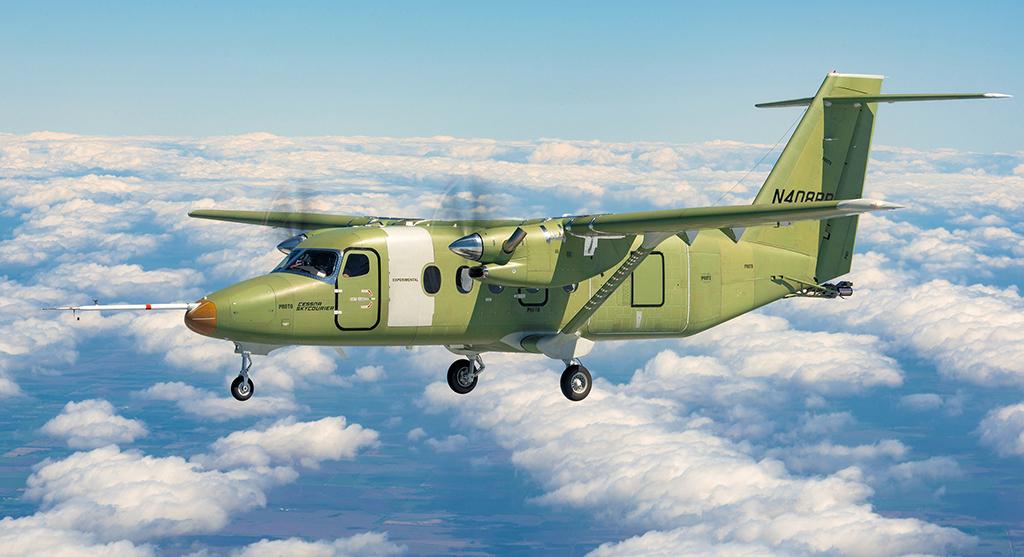
Cessna SkyCourier
Credit: Textron
May 17: A pair of McCauley Blackmac four-blade, aluminum, reversible propellers turned by 1,100-shp Pratt & Whitney PT6A-65SC turbines put daylight under the wheels of the Model 408 for the first time. Five more ground or flying SkyCouriers are expected to speed the certification program which, realistically, seems to have slipped into 2021. Like the engines, the rest of the SkyCourier already is tried and tested: strut-braced wings, a T tail, fixed landing gear and a Garmin G1000 avionics suite. There is no pressurization for the freighter (three LD3 containers, or 6,000-lb. equivalent) or for the commuter version, although the 19 passengers do get fuselage windows. This step-up from the Model 208 Caravan offers cruising at 200 kt. over 400 nm with a 5,000-lb. load, or 900 nm with reduced cargo. Unsurprisingly, FedEx in November 2017 was named as the launch customer for an initial 50 freighters.
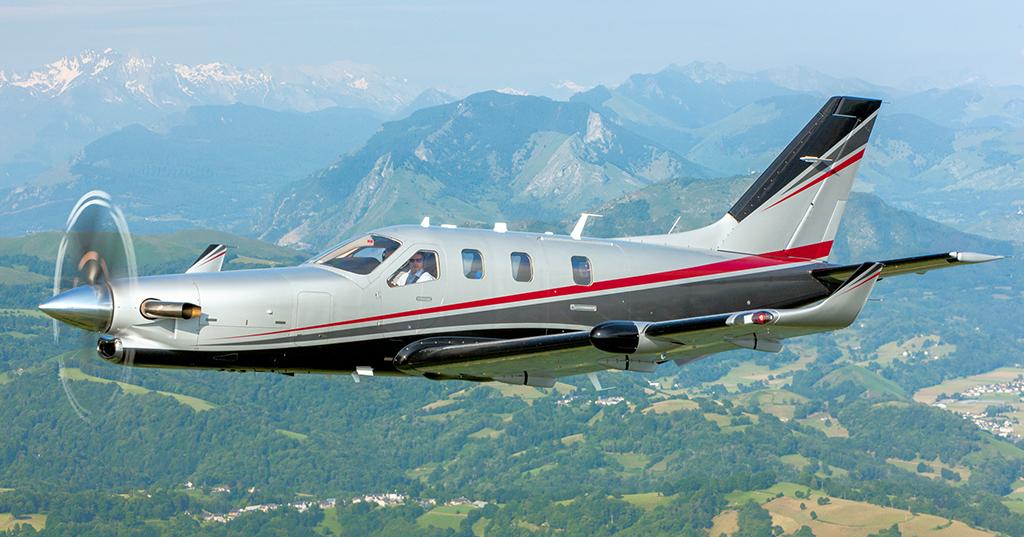
Daher TBM 940
Credit: Daher
Emergence from the French factory of the 1,000th TBM built since 1988 is imminent. Three-quarters of the series are with North American owners. Currently being offered are the Model 910 (Garmin G1000 NXi avionics) and Model 940, introduced in May 2019 as an improvement on the 930 and its Garmin G3000 touchscreen cockpit. A further package of features has been available since February as the 2020 TBM 940 with a HomeSafe emergency autoland system actuated in the event of pilot incapacitation. The 910 and 940 now benefit from the automated icing protection introduced last year as part of Daher’s TBM e-Copilot enhancements. There are also new interior styles and colors and the option to replace one of the four cabin seats with a storage cabinet. A single Pratt & Whitney PT6A-66 turbine driving a five-blade Hartzell propeller offers a 330-kt. cruising speed and range of 1,730 nm.
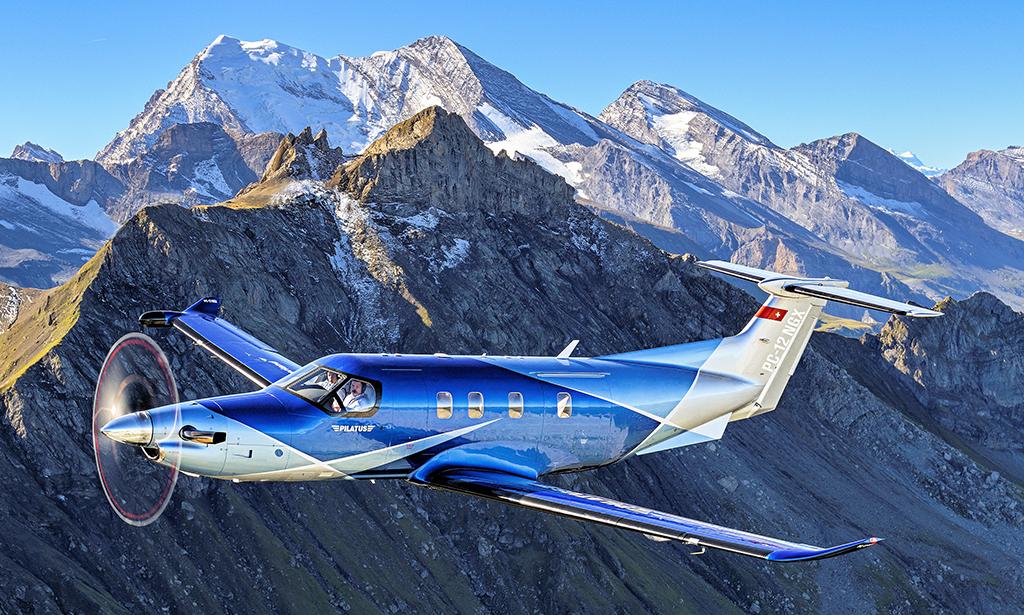
Pilatus PC-12 NGX
Credit: Pilatus
Kept secret until the first production machine was unveiled at the Las Vegas BACE last Oct. 21, the NGX is the second significant upgrade in 30 years for this Swiss utility turboprop. It retains the Pratt & Whitney PT6 engine, but in latest, PT6E-67XP form, rated at 1,100 shp for a 290 kt. maximum cruising speed. It is priced at $4.4 million in basic form or $5.4 million with the executive interior—meaning features borrowed from the PC-24 jet such as cabin design, new seats and 10% larger windows. A useful recognition feature, the windows are more rectangular than previously. Maximum range has been extended to 1,765 nm, and there are new technologies such as tactile feedback in unusual attitudes and an emergency descent mode. There are other benefits: stretched time-between-overhauls means smaller maintenance bills; and selection of low prop-speed mode (1,700 vs. 1,550 rpm) makes passengers and neighbors happier. The freight door and 11-person interior remain unchanged. More than 1,700 PC-12s have been delivered since 1991.
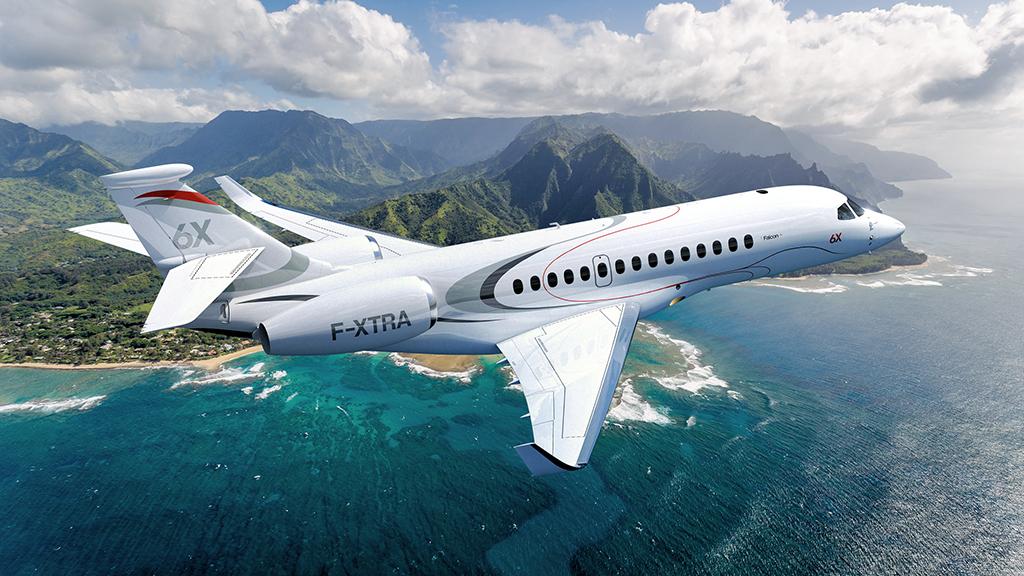
Dassault Falcon 6X
Credit: Dassault
First flight is expected next year for the successor to the abandoned 5X. Its 13,460-lb.-thrust PW812D turbofans—predicted by Pratt & Whitney to be 15 EPNdB below Stage 4 noise limits—will power what is being billed as “the tallest, widest cabin in business aviation:” 40 ft., 4 in. long, 6 ft., 6 in. high and 7 ft., 2 in. wide at the floor (8 ft., 6 in. maximum), not including cockpit and baggage. Three standard floorplans are offered, accommodating up to 14 passengers. Air conditioning is zoned in the cockpit, galley, and forward and aft in the cabin. The pressurized equivalent altitude is 3,900 ft. at FL410, increasing to a still-comfortable 6,000 ft. at the FL510 limit. Dassault’s EASy III avionics, including RDR4000 weather radar and FalconEye HUD and EVS to Land, ease the pilots’ workload. NBAA IFR ranges are 5,500 nm with eight passengers at Mach 0.80, or 5,100 nm at Mach 0.85.
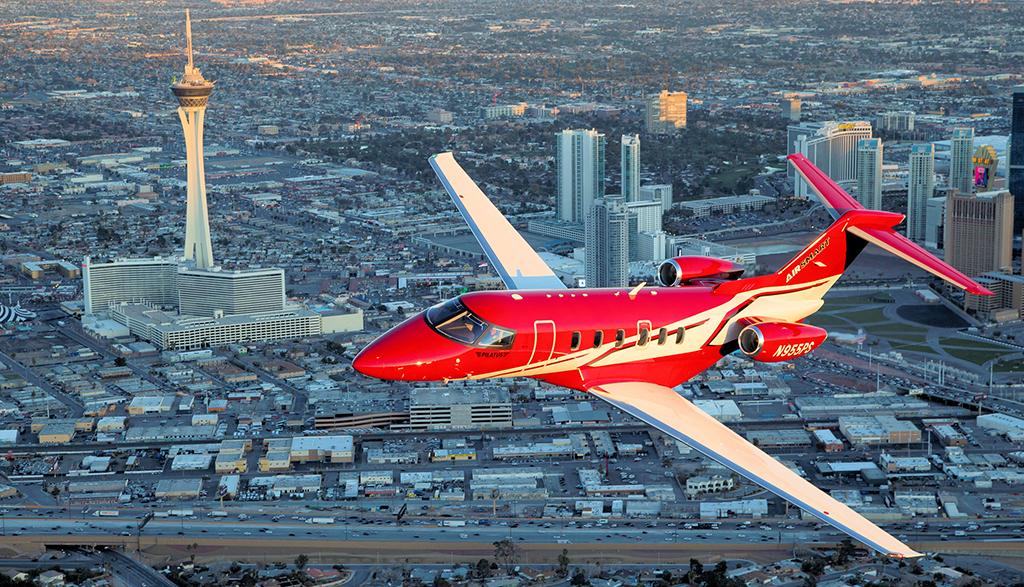
Pilatus PC-24
Credit: Pilatus
Not your average business jet, this $10.1 million example of Swiss engineering has a freight door, rapidly removable seats and signoffs for operation from grass, gravel, dry sand, wet earth and snow. As such, Pilatus says it deserves a category all its own: Super Versatile Jet. Flying since May 2015 and with 75-plus delivered starting in February 2018, the 3,420-lb.-thrust Williams FJ44-powered twinjet can lift up to 12 people (including a single pilot) from runways of 2,930 ft. Among early recipients was Australia’s Royal Flying Doctor service, which appreciates the wide door for loading stretchers and a lack of dependency on concrete. Capable of cruising at 440 kt. at 28,000 ft., the PC-24 will, at long-range speed, cover 1,800 nm with six passengers (1,200 lb) or 2,000 nm with four (800 lb). Pilatus ACE avionics, developed with Honeywell, include a synthetic vision system and an autothrottle. Galley and lavatory upgrades are underway.
Recovery in business aviation will be spurred by a raft of new models just entering service or planned for the near future. All the major manufacturers have new products.
